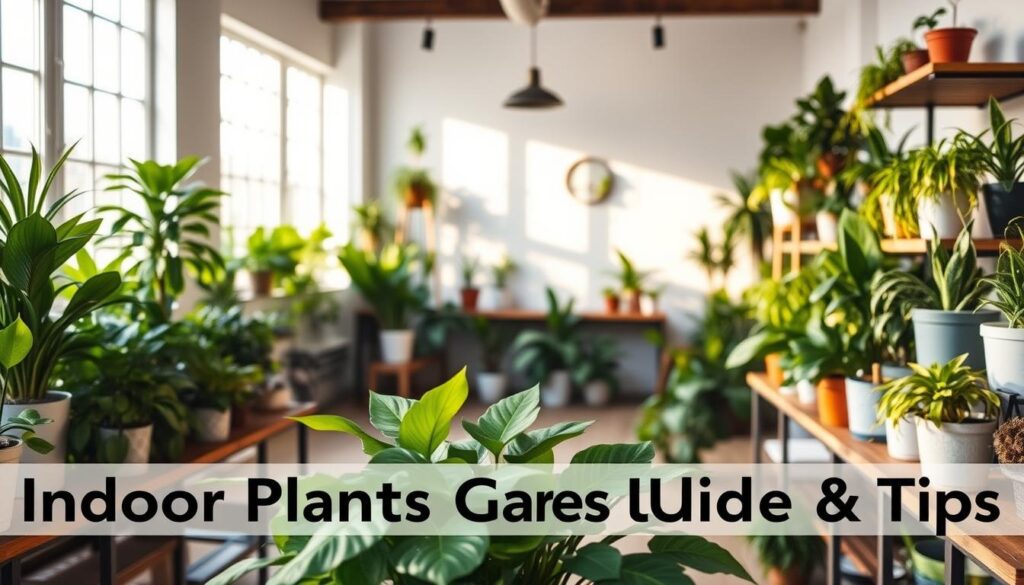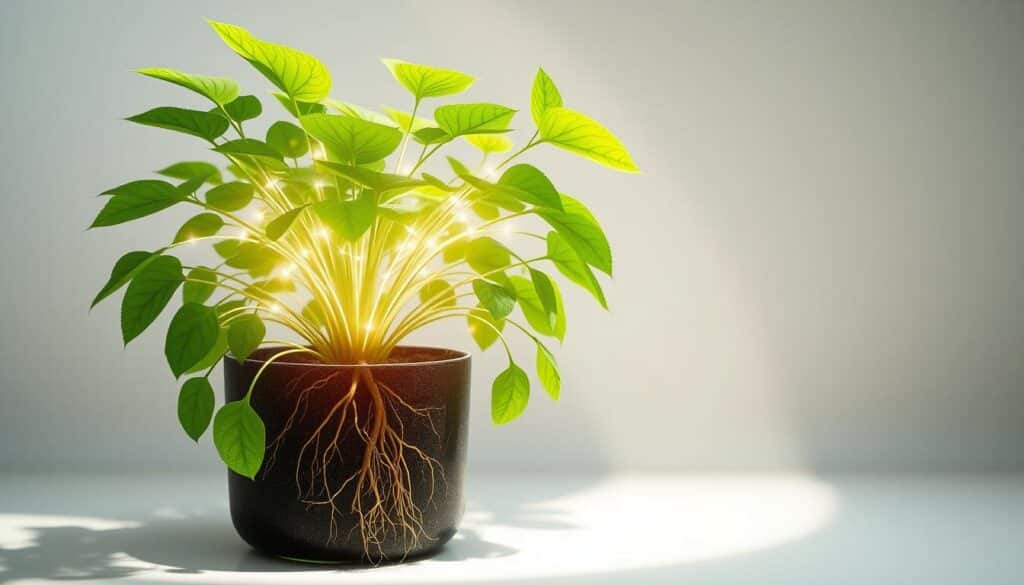Indoor Plants Care Guide & Tips | Green Thumb

About the Game
Welcome to the ultimate guide on indoor plant care. Here, we’ll help grow your green thumb! No matter if you’re new or experienced in gardening, this guide has everything you need. You’ll learn how to pick the right plants and keep them happy and healthy.
Each plant has its own needs, like water, light, and the right soil. It’s important to start with healthy plants. Healthy plants mean a better chance for a thriving indoor garden. We’ll show you how to pick the best pots and soil for your plants.
Ready to become a plant pro? We’ll share tips on keeping the perfect temperature and humidity for your plants. Watch your plants for signs they’re doing well. Follow our advice, and you’ll have a beautiful indoor garden in no time!
Anúncios
Understanding Indoor Plants
Starting an indoor garden means knowing about different kinds of indoor plants. There are mainly three types: succulents, flowering plants, and foliage plants. Each group has its own care needs.
Succulents are easy to care for because they hold water well. They need bright light and soil that drains well to avoid root problems. Flowering plants require certain light and water to bloom. They bring color and sweet smells to any room. Foliage plants have big green leaves. They like light but not direct sun and enjoy a bit of moisture. They are great for indoors.
Anúncios
Knowing what your plants need makes your indoor garden better. Think about how much light you have, the soil you’re using, and how to take care of each plant. Picking plants that fit your lifestyle and your home can make your indoor garden flourish. It also makes your space more beautiful.
Essential Watering Techniques for Healthy Plants
Watering your indoor plants the right way is key to keeping them healthy and happy. It’s crucial to know when your plants need water. This helps avoid any stress caused by too much or too little water. Setting a regular watering routine, based on what each plant type needs, is very important for their health.
Recognizing When to Water Your Plants
Figuring out when to water your indoor plants is easy. Just check the top layer of soil. Wait until the top 1/2 to 1 inch of soil feels dry. If your plants look droopy or start to wilt, they probably need water. But if the leaves are yellow or mushy, you might be watering them too much.
How Often Should You Water Different Types of Plants?
Having a specific watering plan for different types of plants is key. Here are some general tips:
- Succulents: Water them every two to three weeks, since they hold water in their leaves.
- Flowering plants: These usually need water once a week, but it depends on the air moisture and light.
- Foliage plants: They do best with a watering schedule every 7 to 10 days.
Stick to these guidelines to keep your plants well-watered and growing strong.
Optimal Light Conditions for Indoor Plants
Light is crucial for indoor plant health. Understanding their light needs is key to strong growth. Each plant species needs different light conditions to thrive.
Learning how to give right light is vital for their wellbeing. It makes a big difference in how they look.
Best Light Sources for Different Plants
When picking light for indoor plants, look at light intensity and type they need. For instance, succulents and cacti love direct sunlight. So, a south-facing window works best for them. Ferns and peace lilies, on the other hand, enjoy softer, indirect light.
To make the most of natural light:
- Find out the natural light levels in every room.
- Use grow lights when natural light isn’t enough, like in winter.
- Check your plants often to make sure they get just the right light.
How to Rotate Your Plants for Even Growth
It’s important to rotate your plants regularly. This ensures they grow evenly. Many plants lean towards their light source, which can make them grow unevenly.
By turning your pots every few weeks, you make sure all sides get light. This makes your plants healthier and grow more balanced.
Soil and Drainage: Key Components for Plant Health
Choosing the right soil and ensuring good drainage are key for healthy indoor plants. Knowing which soil is best can really help your plants grow well. We’ll help you find the best soil mixes and stress how important drainage is.
Choosing the Right Soil for Your Indoor Plants
Indoor plant soils vary a lot. Different plants need different soils to do their best. Think about these soil types:
- Potting soil: Great for most houseplants, it has a good mix of nutrients.
- Cactus mix: Good for succulents and cacti, it helps avoid too much water.
- Orchid mix: Its chunky texture lets air flow and water drain, perfect for orchids.
Pick a soil that fits your plant’s natural home for the best growth. The perfect mix helps with water and food for your plant.
Importance of Drainage Holes in Pots
Drainage holes stop water from building up, which can harm your plants. Make sure your pots have holes in the bottom. If they don’t, try these ideas:
- Put gravel or stones at the bottom to help water leave the pot.
- Choose pots with a drainage system to fight against too much water.
- Keep an eye on how wet the soil is to avoid soggy conditions.
By doing these things, you make sure your plants stay healthy and grow strong.
Humidity and Temperature Requirements for Indoor Plants
Keeping the right humidity and temperature is key for plant health. Different plants need different levels of moisture and warmth. By knowing these needs, you can make the perfect environment for your plants.
How to Maintain Ideal Humidity Levels
Humidity affects plant health a lot. Many indoor plants, especially tropical ones, need high humidity. To increase humidity, you can:
- Group plants together. This helps create a moist microenvironment.
- Utilize a humidifier. This keeps moisture levels steady.
- Place a pebble tray with water under pots. Evaporation raises humidity around the plants.
Temperature Considerations for Different Plants
Plant temperature needs vary. Most indoor plants do well between 65°F and 75°F. Here’s how to keep the perfect temperature:
- Avoid putting plants near heating vents or drafty windows. Quick temperature changes are bad for them.
- Watch for heat changes, especially when seasons change.
- Some plants, like succulents, handle more heat. Still, balancing temperature is crucial.
Nutrition: Fertilizing Your Indoor Plants
Keeping indoor plants healthy means knowing about plant food. The right fertilizing boosts growth by giving plants needed nutrients. It’s best to fertilize in spring and summer. That’s when plants grow more and use nutrients well.
When and How to Fertilize Your Plants
When fertilizing, choose the right kind for your plant. Liquid fertilizers work fast, but slow-release ones feed plants over time. Use them as the label says to avoid harming your plants. Watch your plants for signs they’re hungry, like slow growth or leaves changing color.
Understanding Common Nutrient Deficiencies
Fixing nutrient problems makes plants much healthier. If leaves turn yellow, your plant might need more nitrogen. Not enough potassium? Your plant could have weak stems and not flower well. Check your plants often so you can fix any issues quickly. A good fertilization plan keeps your indoor garden happy.

Pruning and Propagation Techniques for Indoor Plants
To keep indoor plants healthy, it’s key to know how and when to prune and propagate them. Doing this makes your indoor garden look better and helps plants grow healthier. By taking care of them regularly, you learn the right times for trimming and encouraging new growth. This improves your skills in caring for indoor plants.
Effective Pruning Methods to Promote Growth
Pruning is vital for keeping indoor plants in good shape. Knowing the right time to prune is important for plant health. Here are some helpful tips:
- Trim dead or yellowing leaves to improve overall health.
- Cut back leggy growth to stimulate bushier foliage.
- Remove any damaged branches to prevent disease spread.
Pruning correctly keeps your plants looking great and growing strong.
Simple Ways to Propagate Your Favorite Plants
Adding to your indoor garden can be easy and fun with simple propagation methods. Try these tips:
- Cuttings: Snip healthy stems, placing them in water until roots develop.
- Dividing: Separate cluster-forming plants into smaller segments for new growth.
- Offsets: For some succulents, remove offsets and plant them in new pots.
By using these techniques, you can grow your plant collection. It also keeps your indoor garden healthy and diverse. Practicing these care tips improves your gardening abilities and the variety of your indoor space.
Common Pests and Diseases that Affect Indoor Plants
Indoor plants bring beauty and a sense of peace. But, they can also attract pests and diseases. It’s very important to spot these problems early. Doing so helps keep infestations under control and saves your plants.
Identifying Common Indoor Plant Pests
There are some pests that you’ll likely run into if you keep indoor plants. Knowing about these pests helps you respond quickly:
- Aphids: These small, sap-sucking insects can be green, black, or brown.
- Spider Mites: These tiny pests create fine webs and thrive in dry conditions.
- Fungus Gnats: Their larvae feed on organic matter in the soil, leading to root damage.
Checking your plants regularly is a good way to catch pests early. Look out for strange spots, changes in color, or webbing. These signs can point to an infestation.
Prevention and Treatment for Plant Diseases
Keeping your plants healthy is crucial to avoid diseases. By cleaning leaves and making sure there’s enough air flow, you can keep away fungi and bacteria. If your plants do get sick, there are several ways to treat them:
- Natural remedies, such as neem oil or insecticidal soap, can be effective against many pests.
- Chemical solutions are available for severe infestations but should be used cautiously.
- Ensuring proper watering practices can help prevent root rot and other moisture-related issues.
Conclusion
Caring for houseplants the right way matters a lot. Our guide showed how light, temperature, and watering play big roles. Underleaf helps you pick the right plants for your space. They make sure your plants stay healthy and look great. Small changes can really help your plants stay lively.
Looking after plants is not just fun; it makes your home and life better. It cleans the air and makes you happier. Joining plant-sharing events or parties adds to the fun. You get to swap tips for healthier plants. Sharing stories of your plant journey can inspire others. It builds a community where everyone supports each other.
Grow your indoor garden by practicing what we discussed. Try growing different plants and always ask for advice when needed. The plant-loving community is always there to help. Here’s to making your home a beautiful green space!
FAQ
What are the essential light requirements for indoor plants?
How can I tell if my plant needs water?
What type of soil is best for indoor plants?
How often should I fertilize my indoor plants?
What common pests should I be aware of with indoor plants?
How can I create ideal humidity for my plants?
What temperature conditions do indoor plants prefer?
How do I prune my plants effectively?
Can I propagate my indoor plants, and if so, how?
What are signs that my plant may have a disease?
Game Details
No
No